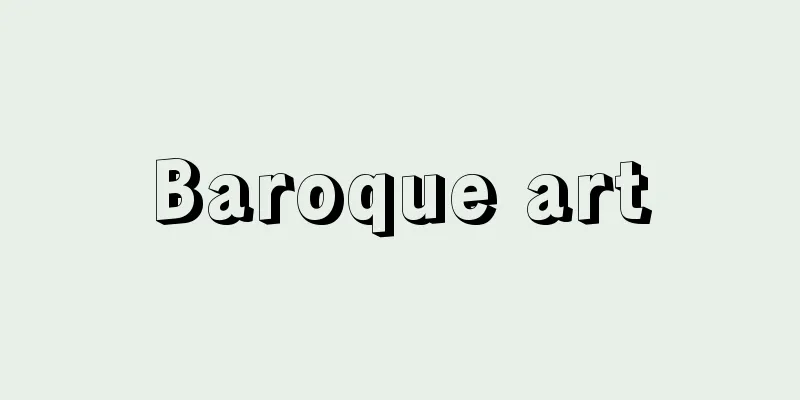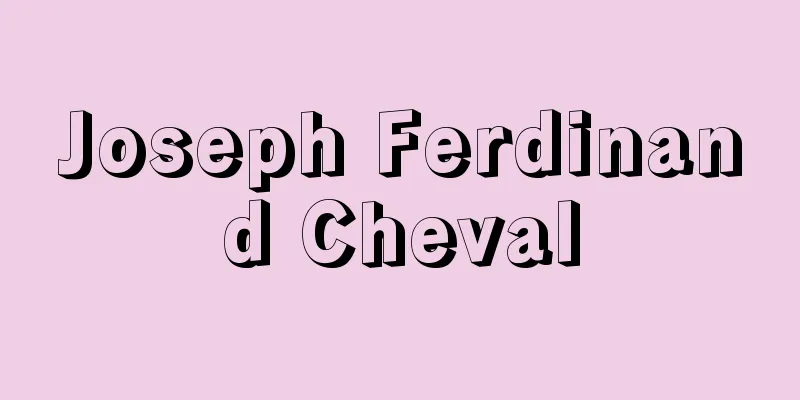Baroque art

|
A European art style from the early 17th century to the first half of the 18th century. The word Baroque is said to derive from the Portuguese or Spanish word barroco, which means "distorted pearl," and was initially used in a negative or derogatory sense to describe this style of excessive decoration that made extensive use of curves. However, since the second half of the 19th century, this kind of etymological meaning has faded, and today it has become an objective concept of an era and style that is used for other arts as well. Baroque originated from the Pope's policy to promote art in order to make Rome the most beautiful city in the Christian world, so it has been called the "expression of the Counter-Reformation," and has also been called the "style of absolutism" as it reflects the taste for luxury and splendor under absolute monarchy. In any case, in contrast to the neat and tidy Renaissance art, Baroque is characterized by dynamic and dramatic expression. [Taro Nomura] Italian BaroqueMichelangelo's design for the dome of St. Peter's Basilica in Rome already contained elements that could be called a prelude to Baroque, and the continuation of work on the cathedral in the early 17th century marked the beginning of a new style. The person in charge of construction and completing the main building at this time was Michelangelo's pupil Maderna, who followed the exterior style created by his master, but created a unique façade that gave a dramatic emphasis to the main entrance area. This façade, in which the spacing between the columns narrows as it approaches the center and the walls gradually protrude forward, was a groundbreaking new concept that created a dynamic relationship with the space as a "façade with depth." The Baroque architect who followed Maderna was Bernini. He is also famous as the perfector of Baroque sculpture, and it was to his great credit that the vast interior space of St. Peter's Basilica was decorated with new-style sculptures, in addition to Palazzo Barberini (basically designed by Maderna), the Vatican Staircase, and St. Peter's Basilica, where he was invited by Louis XIV to participate in the reconstruction of the Louvre. His representative works include "David" (Galleria Borghese, Rome), in which the statue positively embodies a tense space, "Ecstasy of Saint Teresa" (Cornaro Chapel, Santa Maria della Vittoria, Rome), in which the introduction of light sublimates the sense of materiality and expresses a dramatic hallucinatory experience, and "Apollo and Daphne" (Galleria Borghese), in which the statue itself shows a dynamic transformation. Bernini's rival in architecture was Borromini, who excelled in flexible designs that involved complex interweaving of concave and convex surfaces, and built the Church of San Carlo alle Quattro Fontane and the Church of Sant'Ivoire. His influence blossomed in Turin, where his successor, Guarini, built Palazzo Carignano and the dome of the Chapel of San Sudario in Turin Cathedral. In Rome, Pietro da Cortona designed the Basilica of San Martina and other buildings, as well as the murals of Palazzo Barberini and the ceiling of Palazzo Pitti (Florence). The flowering of Baroque painting was achieved by Caravaggio, who painted many masterpieces for the Contarelli Chapel in the Church of San Luigi dei Francesi in Rome. His technique of deepening the composition through sharp contrasts between light and shadow and carving realistic figures into relief had a great influence on Baroque painting in Flanders, Spain and the Netherlands. Annibale Carracci also pursued luxurious Baroque decorative beauty through rhythmic composition while following the classics, and together with his brother Agostino and cousin Lodovico, founded the Bolognese school, which aimed to overcome Mannerism. Annibale's pupil Reni and Guercino, who was influenced by Lodovico, are also known as fresco painters of this era. Other foreign painters who were active in Italy during this period included Elsheimer from Germany, Paul Bril from Flanders, and Poussin and Claude Lorrain from France. José de Ribera from Spain also studied under Caravaggio and developed the Baroque style. [Taro Nomura] Austrian and German BaroqueIn northern Austria and Germany, Baroque architecture was initially carried out by Italians, but from the end of the 17th century onwards, local architects began to play an active role. In Vienna, Johann Fischer von Erlach, who made the most of Italian tradition in the design of the Church of St. Karl Holomaus, and Hildebrand, who designed the magnificent Belvedere and Schönbrunn Palaces, which foreshadowed the Rococo style, are well known. Other well-known architects include Jakob Brandauer (Melk Abbey on the Danube), Pöppelmann (Zubinger Palace in Dresden), Georg Baer (St. Mary's Church in Dresden), Schlüter (design of the Berlin Palace and interior decoration of the Arsenal), and Balthasar Neumann (Bishop's Palace in Würzburg). Another representative example of late Baroque is the Church of Johannes Nepomuk in Munich (1733-1735), which was built by the Asam brothers at their own expense and which they carried out everything from design to decoration by themselves. [Taro Nomura] Flemish and Dutch Baroque paintingThe Baroque in this region is represented by paintings, and the presence of Rubens is particularly important in Flemish painting. He studied in Italy for eight years from the age of 23, and tried to break down the barrier between Northern and Southern Europe. At the same time, and later after settling in Ambers (Antwerp), he made a great contribution to the internationalization of the Baroque style by visiting the royal palaces of the major European countries on diplomatic missions. During his stay in Italy, he studied ancient sculpture, masterpieces of the High Renaissance (his copies of Leonardo are especially famous), and works by Caravaggio and Annibale Carracci, and the results of his studies are most evident in the panel painting of the altarpiece of the Ambers Cathedral, which he started after returning to the country. The ten years after 1620 were the most productive period for Rubens and his workshop, producing many dramatic and magnificent decorative paintings for churches and royal palaces in European countries. Among his most famous works is the series for the Luxembourg Palace in Paris (now in the Louvre and other museums) that celebrates the life of Marie de' Medici, wife of King Henry IV of France, in which Rubens combines mythology and allegory to create a spectacular spectacle of brilliant color and form. His workshop produced Van Dyck, an accomplished successor who was active internationally. In Dutch painting, Rembrandt stands out. Although he never set foot on Italian soil in his life, it is believed that he was clearly inspired by indirect contact with Caravaggio. The dramatic composition of light through the concentrated use of light, as seen in "Samson Blinded," a work he created at the age of 30, is a typical example of Baroque, but this reaches its peak in "The Night Watch." It is a masterpiece in the history of painting, in which the figures are layered in the deep depths of light and dark, giving the large painting a dynamic sense of tension. However, the painting was not well received by the client, as the faces of the figures are in shadow or partially hidden, and it is said to have been a turning point that led to Rembrandt's solitude in the latter half of his life. From this period onwards, his paintings internally promoted idealism in terms of light and realism in terms of form, producing masterpieces of religious paintings and self-portraits that sublimate the verbosity of Baroque into serious internal drama. [Taro Nomura] Spanish BaroqueFrom the end of the 17th century to the first half of the 18th century, a unique Baroque architecture developed in Spain, which combined Italian Baroque with styles introduced from Spain and Latin American styles such as the Maya, Aztec, and Inca, in order to create highly decorative and hallucinatory spaces. This was the so-called Churriguera style, and its pioneer, José Churriguera, mobilized his two sons and many of his students to create the magnificent 30-meter-high altar screen of St. Stephen in the Church of San Esteban in Salamanca. Other notable examples include the Transvalente Chapel in Toledo Cathedral, the sacristy of the Cult Monastery in Granada, and the façade known as the "Obright" of the Cathedral of Santiago de Compostela. In terms of painting, Seville was the central city of Spanish Baroque painting. Zurbarán was a central figure in the Sevillian school, and was called the "Spanish Caravaggio" for his intense naturalistic style. His contemporary, Velázquez, was also from Seville, and was influenced by Ribera and Caravaggio from an early age, painting ordinary people in a realistic style. Velázquez later went to Madrid, where he became the court painter of Philip IV, and was acquainted with Rubens, who had come to the city on a diplomatic mission. During his travels in Italy, he mainly studied the colors of the Venetian school, and after returning to the United States, he painted "The Siege of Breda," which achieved a groundbreaking effect with its natural composition, and in many of his portraits, such as his masterpiece "Las Meninas," he pursued light in a purely visual way. [Taro Nomura] French BaroqueHere, Baroque architecture was absorbed by Jacques Lemercier, Francois Mansart and others, but in this country where the tradition of humanism closely related to the Italian Renaissance is deeply rooted, Baroque took on a strikingly classical color. In fact, in France, Baroque is sometimes referred to specifically as the "Style of Louis XIV," and in this sense, the symbolic architecture of the French absolute monarchy was the large-scale construction of the Palace of Versailles, ordered by Louis XIV. It was designed by Hardouin Mansart, the landscaping by Le Notre, and the decoration by the painter Lebrun. In painting, Bouet, Caro, the Le Nain brothers, and Georges de La Tour are mentioned, and in sculpture, while Girardon and Coazebo are classical in style, Puget shows intense emotional expression. In the British Baroque period, notable figures include Christopher Wren, who rebuilt St. Paul's Cathedral in London, and the painter Hogarth, who used satire as his weapon. [Taro Nomura] "Baroque Art" by V. L. Tapié, translated by Takashina Shuji and Sakamoto Mitsuru (Hakusuisha, Que sais-je Bunko)" ▽ "The World Art Series 16: Baroque Art" by Hijikata Sadakazu (1976, Gakken)" ▽ "Baroque Theory" by A. Daws, translated by Naruse Komao (1969, Chikuma Shobo)" [References] | |The world's largest Christian cathedral and the head temple of the Roman Catholic Church. Renaissance and Baroque sculptures are found throughout. The cupola (dome) is 132.5m high and 42m in diameter. Part of the World Heritage Site "Vatican City" (Vatican City, registered in 1984) Vatican City ©Masashi Tanaka "> St. Peter's Basilica A former villa for the House of Habsburg. Also known as the residence of Empress Maria Theresa. Designed by architect Fischer von Erlach, it is a representative example of Austrian Baroque architecture. World Heritage Site "Schönbrunn Palace and Gardens" (Austria, registered in 1996) Vienna, Austria ©Fam. Kanagawa "> Schoenbrunn Palace 1642 Oil painting , Rijksmuseum, Amsterdam "> Rembrandt "The Night Watch" Probably 1630s Oil on canvas, Metropolitan Museum of Art The Fortune Teller by Georges de La Tour Source: Shogakukan Encyclopedia Nipponica About Encyclopedia Nipponica Information | Legend |
|
17世紀初頭から18世紀前半にかけてのヨーロッパ美術の様式。バロックBaroqueの語源はポルトガル語もしくはスペイン語で「ゆがんだ形状の真珠」を意味するbarrocoに由来するといわれ、初め「不規則な」「グロテスクな」といった否定的ないしは侮蔑(ぶべつ)的な意味で、曲線を多用した装飾過剰のこの様式をよぶのに用いられた。しかし、19世紀後半以降その種の語源的意味は薄れ、今日では美術以外の他の芸術についても用いられる、客観的な時代および様式の概念となった。バロックは、ローマをキリスト教世界でもっとも美しい都市にしようとするローマ教皇の美術振興策に端を発しているため「反宗教改革の表現」とよばれ、さらに絶対王制下の豪奢(ごうしゃ)・華麗な趣味を反映するものとして「絶対主義の様式」ともいわれたことがある。いずれにせよ、端正なルネサンス美術に対して、動感に満ちた劇的表現を特色とする。 [野村太郎] イタリアのバロックミケランジェロによるローマのサン・ピエトロ大聖堂の丸屋根の設計に、すでにバロックの序曲ともいうべき要素が認められ、17世紀初めのこの大聖堂の工事続行が新しい様式の発端となった。このとき工事主任となって本棟を完成したのはミケランジェロの弟子マデルナであるが、彼は師の創案した外観形式を踏襲しつつ、正面玄関の部分に劇的な強勢を与える独自のファサードをつくりだした。支柱の間隔が中央部に近づくにつれて狭くなり、壁面がしだいに前面にせり出してくるこのファサードは、「奥行をもつファサード」として空間と動的な関連性を生み出す画期的な新構想であった。マデルナに続くバロックの建築家にベルニーニの名があげられる。パラッツォ・バルベリーニ(基礎設計はマデルナ)、バチカン宮の階段、サン・ピエトロ大聖堂などのほか、ルイ14世に招かれてルーブル宮改築工事にも参画した彼は、バロック彫刻の完成者としても名高く、広大なサン・ピエトロ大聖堂の内部空間を新様式の彫刻で飾ったのは彼の力に負うところが大きい。彫刻の代表作には、彫像が積極的に緊迫した空間をはらんでいる『ダビデ像』(ローマ、ボルゲーゼ美術館)、光の導入によって物質感を止揚し劇的な幻覚体験を表出している『聖テレジアの法悦』(ローマ、サンタ・マリア・デッラ・ビットーリア教会のコルナーロ礼拝堂)、さらに彫像それ自体が変容の動態を示す『アポロンとダフネ』(ボルゲーゼ美術館)がある。建築におけるベルニーニの好敵手はボロミーニで、彼は凹面と凸面との複雑に交錯する弾力的な設計を得意とし、サン・カルロ・アッレ・クァットロ・フォンターネ教会、サンティボ教会堂などを建造した。彼の影響はトリノで開花し、後継者グアリーニによってパラッツォ・カリニャーノ、トリノ大聖堂の聖スダリオ礼拝堂の円蓋(えんがい)などが建設された。なおローマでは、サン・マルティナ聖堂などの設計、パラッツォ・バルベリーニの壁画、パラッツォ・ピッティ(フィレンツェ)の天井画などの作があるピエトロ・ダ・コルトーナがいる。 バロック絵画の開花は、ローマのサン・ルイージ・ディ・フランチェーシ教会のコンタレリ礼拝堂に多くの大作を描いたカラバッジョによる。光と影との鋭い対比によって構図を深め、形象を写実的に浮彫りしてゆく彼の手法は、フランドル、スペイン、オランダのバロック絵画に多大の刺激を与えた。またアンニバーレ・カラッチも、古典に準拠しつつリズミカルな構成によって豪華なバロック的装飾美を追求し、兄アゴスティーノ、従兄(いとこ)のロドビコと協力してマニエリスムの克服を目ざすボローニャ派を創始した。アンニバーレの弟子レニ、ロドビコの影響を受けたグエルチーノもこの時代のフレスコ画家として知られる。 なお、この時代にイタリアにあって活躍した外国の画家として、ドイツのエルスハイマー、フランドルのパウル・ブリル、フランスのプサンとクロード・ロランがいる。スペインのホセ・デ・リベラもカラバッジョに学んでバロック様式を発展させた。 [野村太郎] オーストリアとドイツのバロック北方のオーストリアとドイツでは、バロック建築は初めイタリア人の手で行われていたが、17世紀末以降、地元出身の設計家の活躍が始まる。ウィーンでは、聖カール・ホロメウス教会堂の設計でイタリアの伝統をもっともよく生かしたヨハン・フィッシャー・フォン・エルラハ、ロココを予見させる華麗なベルベデーレ宮とシェーンブルン宮を設計したヒルデブラントが知られる。そのほか、ヤコブ・ブランタウアー(ドナウ河畔のメルク修道院)、ペッペルマン(ドレスデンのツビンガー宮)、ゲオルク・ベール(ドレスデンの聖マリア教会)、シュリューター(ベルリン宮の設計と兵器廠(しょう)の内部装飾)、バルタザール・ノイマン(ウュルツブルクの司教宮殿)らが知られる。また後期バロックの代表作例に、アサム兄弟が自費で建立し、設計から装飾までいっさいを2人の手で行ったミュンヘンのヨハネス・ネポムク教会(1733~1735)がある。 [野村太郎] フランドルとオランダのバロック絵画この地方のバロックは絵画によって代表されるが、まずフランドル絵画ではルーベンスの存在がとくに重要である。彼は23歳から8年間イタリアに学び、北欧と南欧の壁を打破することに努める一方、当時およびその後アンベルス(アントウェルペン)に定住してからも、外交上の使命を帯びてヨーロッパの主要国家の王宮を訪問し、その際バロック様式の国際化に多大の貢献をした。彼がイタリア滞在中に熱心に研究したのは、古代彫刻、盛期ルネサンスの傑作(レオナルドの模写はとくに有名)、およびカラバッジョやアンニバーレ・カラッチの諸作であったが、その成果は帰国後最初に手がけたアンベルス大聖堂の板絵の祭壇画『十字架立て』に顕著に示されている。1620年以後の10年間は、ルーベンスと彼の工房のもっとも多産な時期で、ヨーロッパ諸国の教会や王宮のために、多数のドラマチックで華麗な装飾画をつくっている。なかでも有名なものが、フランス国王アンリ4世の妃マリ・ド・メディシスの生涯をたたえたパリのリュクサンブール宮の連作(現在ルーブル美術館その他蔵)で、ルーベンスは神話と寓意(ぐうい)とを動員し、色彩とフォルムの絢爛(けんらん)たる一大スペクタクルに仕上げている。彼の工房からは、優れた後継者として国際的に活躍したファン・ダイクを出した。 オランダ絵画では、レンブラントの存在がぬきんでている。彼は生涯に一度もイタリアの地を踏んだことはなかったが、明らかにカラバッジョとの間接的な接触によって刺激されたとみなされている。30歳の作品『目をつぶされるサムソン』にみられる光の集中的な利用によるドラマの構成は、バロックの特徴的な作例だが、これは『夜警』で最高潮に達する。群像を明暗の深い奥行のなかで重層的に処理し、大画面にダイナミックな緊張感を与えた絵画史上の傑作だが、依頼主にとっては表情が影になったり部分的に隠れているこの絵は不評で、以後レンブラントの後半生を孤独に追いやった分岐点をなしたともいわれている。この時期以後、彼の絵は光に対する理想主義と形象に対する写実主義とを内面的に推し進めて、バロックの饒舌(じょうぜつ)を内的に深刻なドラマに昇華する宗教画や自画像の傑作を生んだ。 [野村太郎] スペインのバロック17世紀末から18世紀前半にかけて、スペインでは独特のバロック建築が発展するが、それはイタリア・バロックにスペイン伝来の様式や、マヤ、アステカ、インカの中南米様式を加えた装飾性に富む幻覚的な空間の構築に向かった。いわゆるチュリゲーラ様式がそれで、その先駆者ホセ・チュリゲーラは、2人の息子と多くの弟子を動員して、サラマンカのサン・エステバン教会堂に高さ30メートルに及ぶ壮麗な聖ステパノの祭壇衝立(ついたて)をつくった。その他の特色ある作例では、トレド大聖堂内トランスバレンテ礼拝堂、グラナダのカルト派修道院聖器室、サンティアゴ・デ・コンポステラ大聖堂の「オブライト」とよばれるファサードなどが名高い。絵画ではとくにセビーリャがスペイン・バロック絵画の中心的都市であった。スルバランはこのセビーリャ派の中心的存在で、その激越な自然主義的作風により「スペインのカラバッジョ」と称せられた。彼と同時代のベラスケスもセビーリャ出身で、早くからリベラおよびカラバッジョの影響を受けて、市井の人物を写実的手法で描いた。のちマドリードに出たベラスケスはフェリペ4世の宮廷画家となり、外交的使命を帯びてやってきたルーベンスの知遇を受けた。そしてイタリア旅行で主としてベネチア派の色彩を研究、帰国後描いた『ブレダの開城』では、構成の自然さで画期的効果をあげ、代表作『ラス・メニーナス』など多くの肖像画で、光を純粋に視覚的に追求している。 [野村太郎] フランスのバロックここでは、バロック建築はジャック・ルメルシエ、フランソア・マンサールらによって吸収されたが、イタリア・ルネサンスと密接な関係にある人文主義の伝統の根強いこの国では、バロックは著しく古典主義的色彩を帯びている。事実フランスでは、バロックを「ルイ14世の様式」として限定的によぶこともあり、この意味でフランス絶対王制の象徴的建築は、ルイ14世の命によるベルサイユ宮の大造営であった。その設計はアルドゥアン・マンサール、造園はル・ノートル、装飾は画家ルブランの手にゆだねられた。絵画ではブーエ、カロ、ル・ナン兄弟、ジョルジュ・ド・ラ・トゥールの名があげられ、彫刻ではジラルドン、コアズボの古典風に対して、ピュジェには激しい感情表出がみられる。 イギリス・バロックでは、ロンドンのセント・ポール大聖堂を再建したクリストファー・レン、風刺を武器とした画家ホガースが注目される。 [野村太郎] 『V・L・タピエ著、高階秀爾・坂本満訳『バロック芸術』(白水社・文庫クセジュ)』▽『土方定一著『大系世界の美術16 バロック美術』(1976・学習研究社)』▽『A・ドース著、成瀬駒男訳『バロック論』(1969・筑摩書房)』 [参照項目] | |世界最大のキリスト教聖堂で、ローマ・カトリック教会の総本山。ルネサンスおよびバロック彫刻がいたる所にほどこされている。クーポラ(ドーム)の高さ132.5m、直径42m。世界文化遺産「バチカン市国」の一部(バチカン市国・1984年登録) バチカン市国©Masashi Tanaka"> サン・ピエトロ大聖堂 かつてのハプスブルク家の離宮。女帝マリア・テレジアの居城としても知られる。建築家フィッシャー・フォン・エルラハの設計によるオーストリア・バロックを代表する建築である。世界文化遺産「シェーンブルン宮殿と庭園群」(オーストリア・1996年登録) オーストリア ウィーン©Fam. Kanagawa"> シェーンブルン宮殿 1642年 油彩アムステルダム国立美術館所蔵"> レンブラント『夜警』 おそらく1630年代 油彩メトロポリタン美術館所蔵"> ジョルジュ・ド・ラ・トゥール『女占師』 出典 小学館 日本大百科全書(ニッポニカ)日本大百科全書(ニッポニカ)について 情報 | 凡例 |
>>: Baroque drama - Baroque drama
Recommend
Palmarosa
…Other aromatic plants from the same genus that a...
Sports day - Sports day
A group event centered on physical education, hel...
Caladrius - Caladrius
...In medieval Europe, divination by birds was wi...
Palate - Palate
In vertebrates, the upper wall of the oral cavity ...
Downward motion; descending current
An air current with a downward vertical component....
Izu Three Hot Springs
…This hot spring town developed around Shuzenji O...
Quiroga, Horacio
Born: December 31, 1878, Sarthe [Died] February 19...
electrical synapse
...This is a synapse called a chemical synapse, a...
Bonito (tooth bonito)
A marine fish of the Scombridae family of the Perc...
《Public Affairs》 - Lottery
...His reign spanned the years from Shogun Tokuga...
Go Mun (English spelling) GoMun
…However, this cultural name, which encompasses a...
Horned Owl (Mizuku) - Owl
Among birds of the order Strigiformes, those with ...
Planting - Planting
It refers to planting plants, mainly trees, in a c...
Tears - Namida
This is a physiological fluid present in the conj...
Functional constipation - Yesterday's constipation
...In everyday life, it is used to describe a lon...









